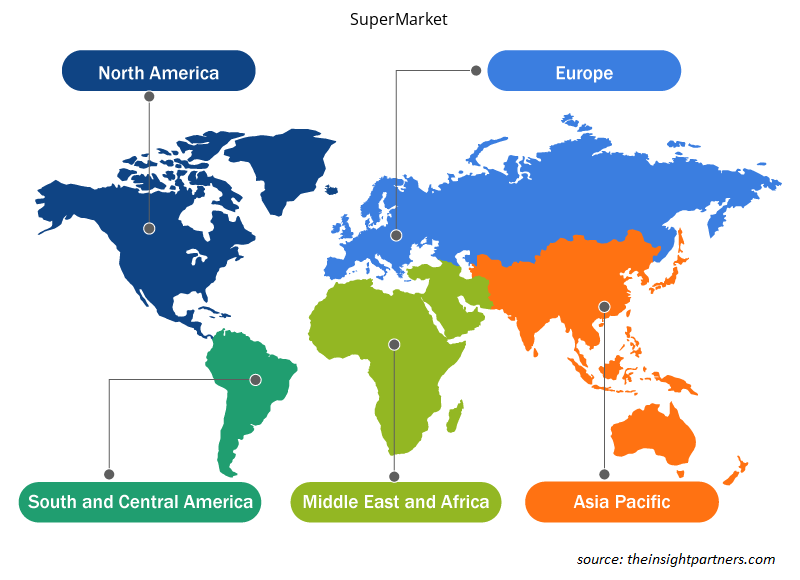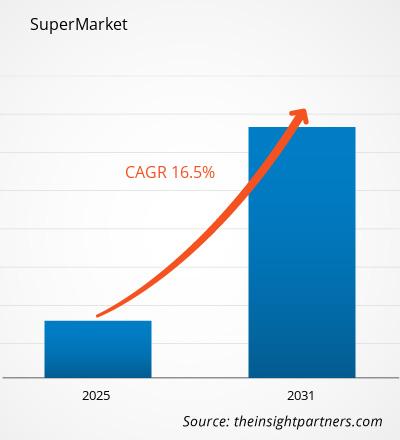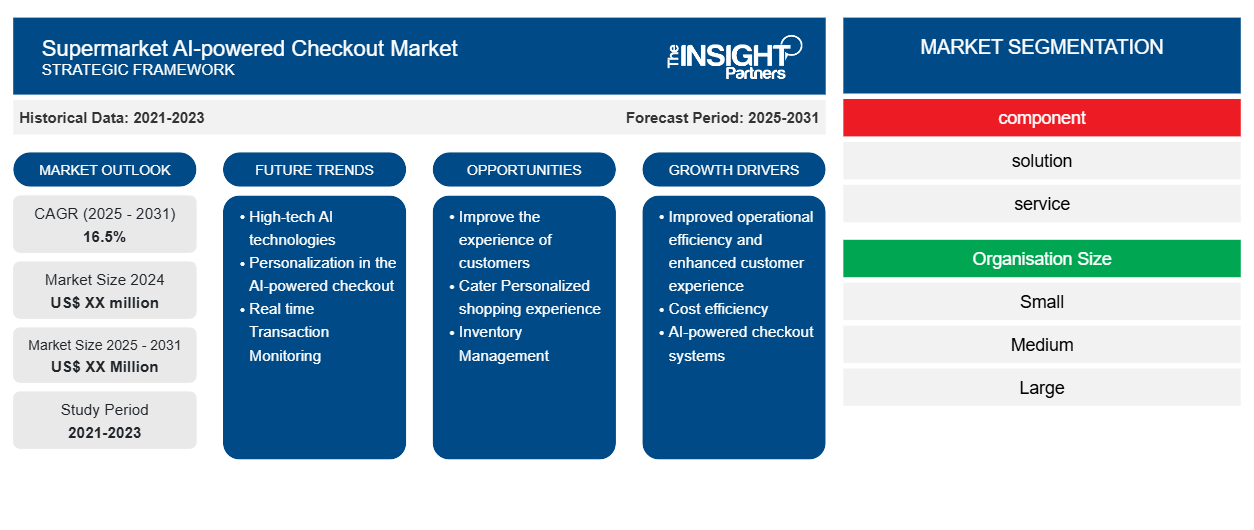من المتوقع أن يسجل سوق السوبر ماركت معدل نمو سنوي مركب بنسبة 16.5٪ من عام 2023 إلى عام 2031، مع توسع حجم السوق من XX مليون دولار أمريكي في عام 2023 إلى XX مليون دولار أمريكي بحلول عام 2031.
يقدم البحث في سوق الدفع بالذكاء الاصطناعي في السوبر ماركت نظرة عامة على الديناميكيات السائدة حاليًا في السوق، إلى جانب اتجاهات النمو التي من المرجح أن يتم ملاحظتها في المستقبل القريب. يسلط التقرير الضوء على المحركات الرئيسية للابتكار، بما في ذلك تحسين تجربة العملاء والكفاءة التشغيلية، وارتفاع المدفوعات غير التلامسية، من بين محركات أخرى، والتحديات التي يواجهها القطاع، مثل الخصوصية وتكاليف التنفيذ.
يتم تقسيم السوق العالمية بناءً على المكونات وحجم المنظمة. يوفر التقسيم نظرة ثاقبة رائعة للوظائف والتفضيلات المحددة التي تدفع كل شريحة.
غرض التقرير
يهدف تقرير SuperMarket الصادر عن The Insight Partners إلى وصف المشهد الحالي والنمو المستقبلي، وأهم العوامل المحركة، والتحديات، والفرص. وسيوفر هذا رؤى لمختلف أصحاب المصلحة في الأعمال التجارية، مثل:
- مزودي/مصنعي التكنولوجيا: لفهم ديناميكيات السوق المتطورة ومعرفة فرص النمو المحتملة، وتمكينهم من اتخاذ قرارات استراتيجية مستنيرة.
- المستثمرون: إجراء تحليل شامل للاتجاهات فيما يتعلق بمعدل نمو السوق، وتوقعات السوق المالية، والفرص المتاحة عبر سلسلة القيمة.
- الهيئات التنظيمية: لتنظيم السياسات ومراقبة الأنشطة في السوق بهدف تقليل الانتهاكات والحفاظ على ثقة المستثمرين ودعم سلامة السوق واستقرارها.
تجزئة السوبر ماركت
عنصر
- حل
- خدمة
حجم المنظمة
- صغير
- واسطة
- كبير
قم بتخصيص هذا التقرير ليناسب متطلباتك
ستحصل على تخصيص لأي تقرير - مجانًا - بما في ذلك أجزاء من هذا التقرير، أو تحليل على مستوى الدولة، وحزمة بيانات Excel، بالإضافة إلى الاستفادة من العروض والخصومات الرائعة للشركات الناشئة والجامعات
- احصل على أهم اتجاهات السوق الرئيسية لهذا التقرير.ستتضمن هذه العينة المجانية تحليلاً للبيانات، بدءًا من اتجاهات السوق وحتى التقديرات والتوقعات.
محركات نمو السوبر ماركت
- Improved operational efficiency and enhanced customer experience: Improved customer experience, being one of the major reasons, is probably why AI checkout systems are being largely adopted. Traditional checkout systems make customers wait for long periods of time, which tends to irritate them. As indicated by a study conducted in 2022 by IHL Group, self-checkout systems can reduce wait times up to 40%. With this checkout streamlining, queues will definitely lessen, since customers can do the transaction at their own pace, which is what most consumers who are tech-savvy like.
- Cost efficiency: Automating checkouts helps supermarkets save labor costs by a huge margin. A McKinsey report says that automated solutions can help retailers save up to 25% in operational costs. An AI-driven system has the capability to analyze real-time data of customer flow and optimize staffing to ensure that no resource is underdeployed or overutilized without affecting service quality.
- AI-powered checkout systems: These systems enable supermarkets to gain valuable insights through data analytics of customer behaviors. This system will not only provide information on purchase patterns but also help the retailer in devising specific marketing strategies as well as manage product inventory. According to a Deloitte study, data-driven decisions increase the productivity and profitability of retail by approximately 5-6%. Knowing customers' likes, the supermarket would make informed decisions on promotions and stock levels, thus boosting sales and enhancing customer satisfaction. According to one study conducted by JDA and Centiro, 62% of consumers prefer stores which have self-service checkout options. The reason behind this change in attitude in consumer behavior signals a change that needs to occur in the supermarket business to meet the expectations set forth by their consumers.
SuperMarket Future Trends
- High-tech AI technologies: The supermarket AI-powered checkout market is a source of significant transformation, moving from several key trends reflecting both advances in technology and changing consumer preferences. After all, today's consumer would like to shop more quickly and conveniently. Because of that, one of the major trends that is finding a hold in the retail sector is an increase in self-checkout systems. Many supermarkets already deploy AI-based self-checkout systems to enable customers to scan items for purchase and independently make a payment. With this, it reduces waiting in line, thus improving customer overall satisfaction. The other critical trend involves the incorporation of high-tech AI technologies like machine learning and computer vision into checkout systems. This sets processes running smooth and automated for item scanning and processing of payments with minimal human error, hence high levels of accuracy. It has been shown from research that a considerable proportion of consumers do not mind adopting this technology if it will add some value to their shopping experience.
- Personalization in the AI-powered checkout: supermarkets exploit data analytics to offer relevant and personalized one-to-one promotions and product recommendations upon checkout. Supported by the analysis of customers' buying behavior, AI can make personalized offers that appeal directly to every unique taste, thus fostering loyalty and encouraging repeat business.
- Real time Transaction Monitoring: While the technology of automation rises, security has become a major concern for AI-powered checkout systems. These can monitor transactions in real time and flag those which may be suspicious or fraudulent activities. As retail theft is an extremely costly one for supermarkets, the use of AI with enhanced security features to contribute to lesser shrinkage protects the profitability of a supermarket business.
SuperMarket Opportunities
- Improve the experience of customers: Attacting better CX by reducing waiting time through features such as automatic checkout and smart carts. Customers can scan their items as they shop; this will give them an efficient and smooth checkout. Supermarkets will have a greater chance of improving customer satisfaction and loyalty from these systems, further foreseen to improve supermarket AI-powered checkout market share in coming.
- Cater Personalized shopping experience: AI can analyze customers' purchase histories and preferences. That gives recommendations and promotions at the point of checkout. This will be a pleasant shopping experience and will also encourage incremental sales since customers are likely to purchase something that comes up as their recommendation and is of interest to them.
- Inventory Management: AI-integrated checkout systems will provide real-time views of inventory. By observing the constant purchasing of certain products together, or trending customer behaviour, supermarkets will be able to keep the appropriate levels of stock and optimize the supply chain by reducing waste and further improving profitability.
Supermarket AI-powered Checkout Market Regional Insights
The regional trends and factors influencing the Supermarket AI-powered Checkout Market throughout the forecast period have been thoroughly explained by the analysts at Insight Partners. This section also discusses Supermarket AI-powered Checkout Market segments and geography across North America, Europe, Asia Pacific, Middle East and Africa, and South and Central America.

- Get the Regional Specific Data for Supermarket AI-powered Checkout Market
Supermarket AI-powered Checkout Market Report Scope
| Report Attribute | Details |
|---|---|
| Market size in 2023 | US$ XX million |
| Market Size by 2031 | US$ XX Million |
| Global CAGR (2023 - 2031) | 16.5% |
| Historical Data | 2021-2022 |
| Forecast period | 2024-2031 |
| Segments Covered | By component
|
| Regions and Countries Covered | North America
|
| Market leaders and key company profiles |
|
Supermarket AI-powered Checkout Market Players Density: Understanding Its Impact on Business Dynamics
The Supermarket AI-powered Checkout Market market is growing rapidly, driven by increasing end-user demand due to factors such as evolving consumer preferences, technological advancements, and greater awareness of the product's benefits. As demand rises, businesses are expanding their offerings, innovating to meet consumer needs, and capitalizing on emerging trends, which further fuels market growth.
Market players density refers to the distribution of firms or companies operating within a particular market or industry. It indicates how many competitors (market players) are present in a given market space relative to its size or total market value.
Major Companies operating in the Supermarket AI-powered Checkout Market are:
- Mashgin, Inc.
- AiFi Inc.
- FOCAL SYSTEMS INC.
- Accel Robotics Corporation
- Toshiba Corporation
Disclaimer: The companies listed above are not ranked in any particular order.

- Get the Supermarket AI-powered Checkout Market top key players overview
Key Selling Points
- Comprehensive Coverage: The report comprehensively covers the analysis of products, services, types, and end users of the SuperMarket, providing a holistic landscape.
- Expert Analysis: The report is compiled based on the in-depth understanding of industry experts and analysts.
- معلومات محدثة: يضمن التقرير أهمية الأعمال التجارية بسبب تغطيته للمعلومات الحديثة واتجاهات البيانات.
- خيارات التخصيص: يمكن تخصيص هذا التقرير لتلبية متطلبات العملاء المحددة وبما يتناسب مع استراتيجيات العمل بشكل مناسب.
وبالتالي، فإن تقرير البحث عن السوبر ماركت يمكن أن يساعد في تمهيد الطريق لفك شفرة وفهم سيناريو الصناعة وآفاق النمو. ورغم أن هناك بعض المخاوف المشروعة، فإن الفوائد الإجمالية لهذا التقرير تميل إلى التفوق على العيوب.
- التحليل التاريخي (سنتان)، سنة الأساس، التوقعات (7 سنوات) مع معدل النمو السنوي المركب
- تحليل PEST و SWOT
- حجم السوق والقيمة / الحجم - عالمي، إقليمي، بلد
- الصناعة والمنافسة
- مجموعة بيانات إكسل
التقارير الحديثة
شهادات العملاء
سبب الشراء
- اتخاذ قرارات مدروسة
- فهم ديناميكيات السوق
- تحليل المنافسة
- رؤى العملاء
- توقعات السوق
- تخفيف المخاطر
- التخطيط الاستراتيجي
- مبررات الاستثمار
- تحديد الأسواق الناشئة
- تحسين استراتيجيات التسويق
- تعزيز الكفاءة التشغيلية
- مواكبة التوجهات التنظيمية





















 احصل على عينة مجانية ل - سوبر ماركت
احصل على عينة مجانية ل - سوبر ماركت